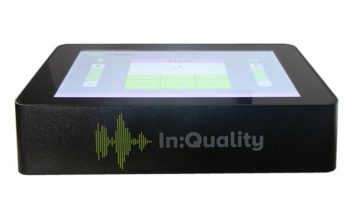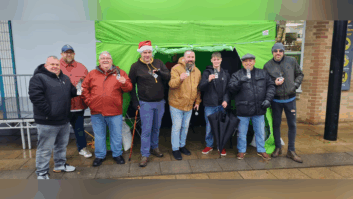Moving studio-grade audio from point to point is much simpler thanks to browser-based programs that use the open source Opus codec.
One such modality is ipDTL from the U.K.’s In:Quality, which I’ve used with success. This web application the Opus codec and allows the originator to send up to six bidirectional links for connection.

This begs a question: How can this process be simplified for two-way sessions (voice overs, program and news contributions) that won’t tie up a laptop or desktop computer?
The founder of In:Quality, Kevin Leach, worked for the BBC as a producer and audio engineer. He says using ipDTL from a computer, is a process that depends on configuring settings such as audio device selection in the right order, to deliver studio grade audio. That’s not a problem for technical people.
[Check Out More Products at Radio World’s Products Section]
Leach says In:Quality’s SIP codecs were designed to increase simplicity and reliability for those who want a simple way to connect to a radio station.
“Once you put everything in a simple box [Raspberry Pi ] it takes away a lot of complexity. The USB SIP codec lets a user connect using a simple USB microphone and headphones, or a USB soundcard. The XLR SIP codec has Neutrik XLR-TRS connections for analog audio, and can also be configured to move audio on any network that recognizes AES67 as a protocol. It is available in a plain version, Zero, that is externally controlled, and a touchscreen-controlled version, Touch.
Here’s what goes in that Raspberry Pi box: a software codec that uses the EBU 3326 protocol and SIP to make calls. The preferred codec is the open source Opus codec, but the software can recognize G.722, G.711 and, where still available and as part of a subscription, ISDN.
Purchasers of In:Quality codecs receive a one-year subscription to the sip.audio service, which is part of the In:Quality family. All sip.audio subscribers can make calls and connect to any other SIP device that allows incoming SIP calls.
The sip.audio website has a growing worldwide directory of facilities and contributors (subject matter experts, voice over artists, et al.) who are SIP enabled. When connecting these codecs, In:Quality strongly recommends that they be connected to a network via Ethernet. In:Quality cautions that some dynamic microphones might not work well with the XLR Codec, due to the available gain in the preamp.
I configured the XLR codec to transmit and receive audio through my Allen + Heath ZED-10. Settings and configuration for the unit were done from a laptop on the same network. Other settings and adjustments can be made from the codec’s touchscreen. Line level mix-minus codec transmit was fed via the ZED-10’s FX send; the line level codec receive was connected through a line level channel, and the codec was connected via Cat-6 to a network switch and router.
Clean audio was transmitted and received between my studio and In:Quality in Manchester, England, KHAS(AM) in Hastings, Neb., and WKBX(FM) in Kingsland, Ga.
Brad Beahm is the operations manager for KHAS/Platte River Media in Hastings, Neb. On a given Friday, he’ll have five separate football broadcasts on five separate stations in his cluster, between Hastings, Grand Island and Kearney, Neb.
“In the past we’ve used Skype and have had a few issues, like having a computer do a Windows update, sound card settings getting changed and forgotten Skype passwords. With the In:Quality SIP codecs, we give them the box and equipment, tell them to push the button for whatever station they’re on and go from there.”
Beahm has the XLR codec in his equipment rack. He deployed a Touch SIP codec for a newscaster who had to move from Nebraska to take care of a relative. The use of the codec allowed that newscaster to continue doing news for the morning show. When asked about the quality of the signal from Colorado to Nebraska, Beahm said “Our morning guy asked if the newscaster had a fan running during the newscast. The signal was clear enough that the fan in the background could be heard. That’s a good problem to have.”
Neal Ardman is the president of NIA Broadcasting and Broadcast Partners and WKBX in Kingsland, Ga. His station uses In:Quality codecs for hosts on remote and for high school football, for which the station will use a dedicated Verizon Mi Fi on Wi-Fi or 5G.
Ardman suggests that those using In:Quality equipment at home insure that there’s enough bandwidth on the home network. “Make sure the talent working from home has a good quality soundcard too, and that’s usually not the one that’s built into the computer.
He also shared a security tip about spoofed IP addresses: “Make sure that your router is set up to accept connections to your codec only from known IP addresses. That way, you don’t have to worry about spoofed IP addresses.”
The XLR Codec from In:Quality has a list price of $449 (Zero) and $499 (Touch with integrated touchscreen).
Paul Kaminski, CBT, is a veteran radio news reporter and host of msrpk.com’s “Radio-Road-Test.” Twitter: msrpk_com.
PRODUCT CAPSULE
In:Quality XLR SIP Zero and Touch Codecs
Plusses
- Low cost
- Clean audio using Opus codec
- sip.audio subscription included
- Web-based configuration
- Easy professional connections (XLR and TRS), no soundcard needed
Minuses
- Some dynamic mics may not work well with the XLR codec
Info: https://inquality.com







